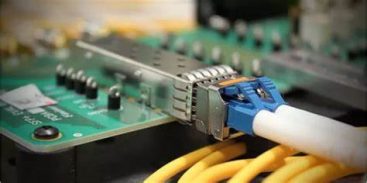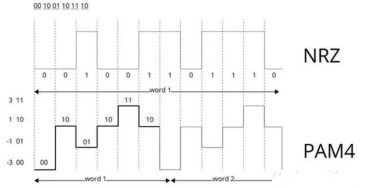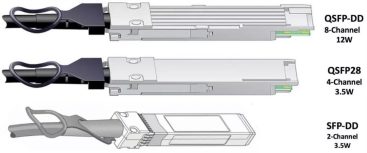200G Data Center: Як вибрати оптичні модулі QSFP56 і QSFP-DD?
З бурхливим розвитком оптичного зв'язку та Інтернет-технологій, попит на мережевий трафік даних зростає в геометричній прогресії, а середньорічний темп зростання мережевого трафіку телекомунікаційних кісток настільки ж високий 50% до 80%. Для того, щоб впоратися зі збільшенням попиту на передачу даних, Коефіцієнт оптичної комунікації продовжує розвиватися з 10 г, 25Г, і 40 г до поточного мейнстріму 100г, 200Г, 400Г, і навіть вище

У цьому контексті, Вибір QSFP56 та QSFP-DD як ключові стандарти інтерфейсу для досягнення 200 г швидкості є особливо важливим при побудові 200 г центрів обробки даних. Модуль QSFP56 - це вдосконалена версія оригінальної конструкції QSFP+, розробленої для підвищення швидкості передачі даних за допомогою оптимізації, У той час як QSFP-DD вводить конструкцію подвійної щільності, яка ефективно збільшує щільність порту та підтримує зворотну сумісність із сімейством продуктів QSFP. Обидва мають власні переваги та характеристики з точки зору ефективності, контроль витрат, енергоефективність, та термічне управління, і в практичних додатках, Необхідно провести всебічну оцінку та розумний відбір відповідно до конкретних потреб бізнесу, Плани розширення, та майбутні тенденції розвитку Центру обробки даних.
Тип пакету 200 г оптичного модуля центру обробки даних
В даний час, Оптичні модулі на ринку 200 г на ринку в основному використовують дві форми пакетів, а саме 200 г QSFP56 та 200 г QSFP-DD. Серед них, QSFP56 був офіційно випущений у 2017, що є основним технічним оновленням на основі ранньої конструкції оптичного модуля серії QSFP, в той час як QSFP-DD знаходиться на стадії досліджень та розробок і поступово з'явився. Обидва типи трансиверів розроблені для задоволення високих вимог до високопродуктивних обчислень і сценаріїв центрів обробки даних, і обидва мають хорошу зворотну сумісність із попередніми версіями QSFP, включаючи QSFP28.
Оптимізовано для програм 200G Ethernet, оптичний модуль QSFP56 має чотири незалежних канали прийому-передавача, кожна підтримує швидкість передачі даних до 53.125 Гбіт/с, в результаті чого загальна пропускна здатність становить 212.5 Гбіт/с. Модуль підходить для 850 нм, 1310нм, Діапазони довжин хвиль CWDM або LWDM, і використовує інтерфейс MPO для передачі оптичного сигналу та підключення електричного інтерфейсу через 38-контактний електричний роз'єм. У порівнянні з попереднім поколінням продуктів QSFP, QSFP56 використовує передову технологію цифрової модуляції PAM4, що значно підвищує ефективність передачі даних.
З іншого боку, QSFP-DD (Quad невеликий форм -фактор, що підключається подвійна щільність) Оптичні приймачі відповідають стандарту IEEE802.3BS та специфікації MSA QSFP-DD. Основна інновація-це конструкція структури подвійної щільності, що збільшує кількість каналів електричного інтерфейсу. Конкретно, 200 г QSFP-DD має вісім електричних смуг інтерфейсу із загальною швидкістю бітів до 212,5 ГБ/с. З точки зору оптичного інтерфейсу, Можна вибрати інтерфейс Duplex LC Duplex Duplex. Варто зазначити, що QSFP-DD не тільки сумісна з більшістю версій специфікації QSFP, наприклад QSFP56, але також містить вісім каналів до 25 GBP в його електричному інтерфейсі, Використання модуляції NRZ для забезпечення ефективної та стабільної передачі сигналу.
Порівняння 200 г QSFP56 та 200G QSFP-DD
У полі 200 г центрів обробки даних, Оптичні модулі у вигляді QSFP56 та QSFP-DD показують значні відмінності у використанні різних технологій цифрової модуляції. NRZ (Неперервне до нуль) є основним і широко використовуваним методом модуляції, який передає дані через два рівні напруги, що відповідають логіці 0 і 1 (Тобто, PAM2). Проте, Як зростає пропускна здатність, PAM4 (Чотирирівнева імпульсна амплітудна модуляція) був розроблений, що дозволяє сигналам PAM4 передавати дані з вдвічі більшими показниками традиційних сигналів NRZ за допомогою чотирьох різних рівнів напруги в одному і того ж одиниці часу: 11, 10, 01, і 00.

Основна перевага PAM4 над NRZ - це його здатність досягти більш високої швидкості передачі даних. Проте, в той час як 200 г NRZ може бути дещо поступатися PAM4 в абсолютній швидкості, Він також має деякі переваги, які неможливо ігнорувати: менше енергоспоживання, невелика затримка сигналу, і відносно простий процес розгортання. Особливо в сценарії взаємозв'язку внутрішньо-даних, Рішення, що використовує 200 г NRZ-модуляції, Особливо в середовищі застосування з високими вимогами до контролю за споживанням енергії, Виконання в режимі реального часу, та обмежений бюджет.
Переваги та обмеження 200 г QSFP56 проти. QSFP-DD
QSFP56 призначений для задоволення потреб 200 г додатків, Але його технічна архітектура не підтримує пряме оновлення до 400 г та вище мережевих середовищ.
Навпаки, QSFP-DD сумісний як з версіями швидкості 200G, так і 400G, і дозволяє користувачам поступово оновлювати за потреби, з більшою масштабованістю та гнучкістю.
З точки зору модуляції, QSFP56 використовує технологію PAM4, в той час як QSFP-DD зазвичай використовує модуляцію NRZ при досягненні 200 г ставок.
З точки зору конфігурації каналів, QSFP56 потребує лише 4 канали для завершення передачі даних на 200 г, Що вигідніше з точки зору вартості волокна та втрат посилань, ніж QSFP-DD, що вимагає 8 канали.
Проте, QSFP-DD пропонує ряд переваг: Зниження витрат на обслуговування, висока ефективність (Пізніше, як E-8 Pre-FEC та E-12), низьке енергоспоживання, низька затримка, та простота розгортання та управління. В додаток, він може гнучко адаптуватися до традиційних специфікацій різної швидкості шляхом розщеплення, що підвищує оновлення мережі та сумісність, і відсталий сумісний з попередніми оптичними модулями QSFP Series, включаючи QSFP56, але не QSFP-DD.
З точки зору ціни, Ціна QSFP-DD приблизно 15% до 30% вище, ніж QSFP56. Хоча початкові інвестиції високі, це частково компенсується меншим енергоспоживанням і затримкою QSFP-DD, враховуючи витрати на довгострокову експлуатацію та обслуговування. Також варто зазначити, що якщо поточне мережеве обладнання загалом не підтримує QSFP-DD, можливо, рентабельніше вибрати QSFP56, оскільки він може зіткнутися з високим тиском витрат при збільшенні швидкості підключення. Проте, якщо у вас є достатній бюджет і ви плануєте майбутнє розширення мережі та оптимізацію продуктивності, QSFP-DD є кращим вибором для наступних оновлень.

Що стосується продуктів 200G AOC і DAC, вони зазвичай використовуються для прямого з'єднання між комутаторами доступу та серверами. Особливо на базовому рівні з’єднання, Ми пропонуємо розгалужені рішення DAC та AOC, які можуть відповідати різним складним вимогам, крім традиційних DAC та AOCS прямого нападу. Ця серія продуктів охоплює різні комбінації швидкості від 200 г розколу до 4х50г, 200G розділити на 8х25 г, і навіть 200 г розколу на 2х100г, Надання більш гнучкого та адаптаційного взаємозв'язку для центрів обробки даних.


